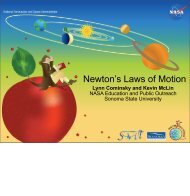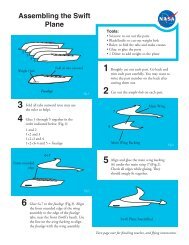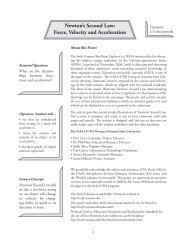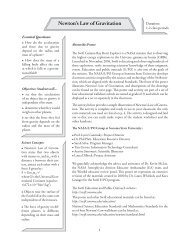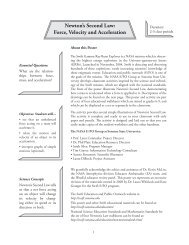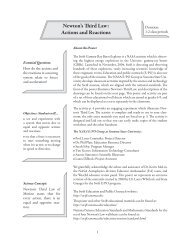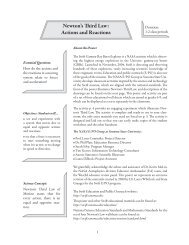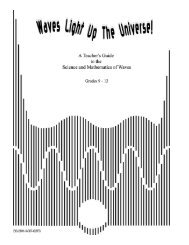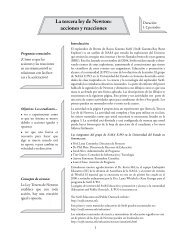Answers to Non-<strong>Swift</strong> Pre-Activity Discussion Questions:When you are riding in a car with a seat belt on, <strong>and</strong> the car starts suddenly, you feel the back of the seat pushagainst your back as the car begins to move. This is because your inertia tries to hold you – in the originalposition – but the car is starting to move forward. Since you are held in the seat by the seatbelt, when the carstops suddenly, you move forward, <strong>and</strong> feel the seatbelt push against you, holding you in place. If you were notwearing your seat belt, you would continue your forward motion as the car stops, <strong>and</strong> would smash into thewindshield or dashboard of the car. The car is providing the unbalanced force as it accelerates or decelerates.Other examples include: flying in an airplane as it takes off <strong>and</strong> l<strong>and</strong>s (wearing a seatbelt!), riding in a train orbus (where seatbelts are not as common because accelerations <strong>and</strong> decelerations are usually more gradual), orskateboarding (where if the wheels of the board hit a rock, the board can stop, but you keep going).Procedure for In-class activity: <strong>Inertia</strong> <strong>and</strong> <strong>Unbalanced</strong> <strong>Forces</strong>:The basic procedure for most students is described in the student’s h<strong>and</strong>out.In addition, you may wish to write vocabulary on the board (such as inertia, force, acceleration) <strong>and</strong> promptthe students to explain their observations using the vocabulary.For advanced students, you can add the post <strong>and</strong>/or extension activities to add additional opportunities forreflection.The answers below pertain to the student questions.Answers to In-Class Activity Questions:Question 2: When the car <strong>and</strong> figure are sitting on the desk, there is no unbalanced force acting on them, sothey do not move (an object at rest tends to stay at rest). There are forces acting on them: gravity, for one, ispulling them down toward the center of the Earth. But this force is exactly balanced by the surface of the desk,which is pushing them up. This may be a difficult concept for the students to underst<strong>and</strong>. One way to explainit to them is to ask them what would happen if the desk were to be replaced by a very thin sheet of rubber. Thecar would sink a bit, stretching the rubber sheet, tightening it. The force of gravity is stronger than the forceof the rubber sheet trying to contract <strong>and</strong> support the car. When the sheet stretches enough, the tension in itis strong enough to balance gravity, <strong>and</strong> once again motion stops.Question 4: When you put the car on the ramp, gravity will act on it, pulling it down. The car <strong>and</strong> figure areboth pulled by gravity, <strong>and</strong> both move down the ramp together. When the car reaches the floor, once againgravity is balanced by the floor itself, so the forces on the car are balanced, yet it keeps moving (an object inmotion tends to stay in motion). It may eventually hit a chair or a wall, but until it does it should move relativelysmoothly. It will slow down due to friction as well.Question 6: When the car hits the book, the car stops <strong>and</strong> the book does not move (or moves very little). Thebook has more inertia than the car, <strong>and</strong> is also being held in place by friction. The book does not move, whilethe motion of the car is stopped. Another way to think of it is that the book applied a large force to the car,stopping it (an object in motion tends to remain in motion unless acted on by an unbalanced force). However,this force is applied only to the car, <strong>and</strong> not to the figure. Since an object in motion tends to remain inmotion, the figure will fly off the car. Ouch!4
Question 8: This is why we use seat belts,to counteract that tendency to remainin motion. The seat belt applies a forceto a person that keeps them from flyingout of the car. Even better are air bags,which apply a smaller force to a personover a larger area than a seat belt, so theperson is protected in more areas thanjust the lap <strong>and</strong> shoulder.Do not try this at home!Question 9: When the car hits the wadded piece of paper, the paper is knocked away. This is because the car hasmore inertia than the paper, so the paper is easier to move. The force from the car is not enough to move the book,but it is easily enough to move the paper.Post-Activity Demonstration (Advanced students):A chunk of dry ice allowed to sit on the floor for a few minutes will get a flat surface underneath it as the warmfloor turns the dry ice into a gas. The chunk of dry ice will float on that gas, like an air hockey puck (see ExtensionActivity below). A small flick of the finger will cause the chunk to move in a straight line across the floor at aconstant speed. It is actually quite odd to see this, since we are used to friction (a force!) slowing things down.Warning: Dry ice is extremely cold, <strong>and</strong> can cause severe frostbite. If you perform this demo,follow safety procedures for dry ice (for example, http://www.abc.net.au/science/surfingscientist/pdf/lesson_plan08.pdf <strong>and</strong> http://www.school-for-champions.com/science/dry_ice.htm). Wear thickgloves, <strong>and</strong> don’t allow the students to touch the dry ice directly.Post-Activity (optional):Watch the demonstration of a chunk of “dry ice” moving across the floor. How does this illustrate Newton’s<strong>First</strong> <strong>Law</strong>?Extension Activity (Advanced students):When <strong>Swift</strong> launched on board the rocket, it was bolted to the rocket. A little over an hour after launch, at1:36 pm, the bolts holding it in place were cut. Then, 30 seconds later, the rocket fired “reverse thrusters” whichbacked it away from the <strong>Swift</strong> spacecraft. You can see the video of this, from a camera on-board the rocket, at:http://www.nasa.gov/mission_pages/swift/timeline/index.htmlHow does the motion of the <strong>Swift</strong> spacecraft in this video illustrate Newton’s <strong>First</strong> <strong>Law</strong>?For a more “down-to-Earth” example, go play air hockey. An air-hockey table is a good example of an almostfrictionless surface. Ask the students the following: Why does the puck stop when the air stops? What makesit frictionless? Would the puck go on forever if it could? (If the walls of the table didn’t stop it.) How is this anexample of Newton’s <strong>First</strong> <strong>Law</strong>?5



